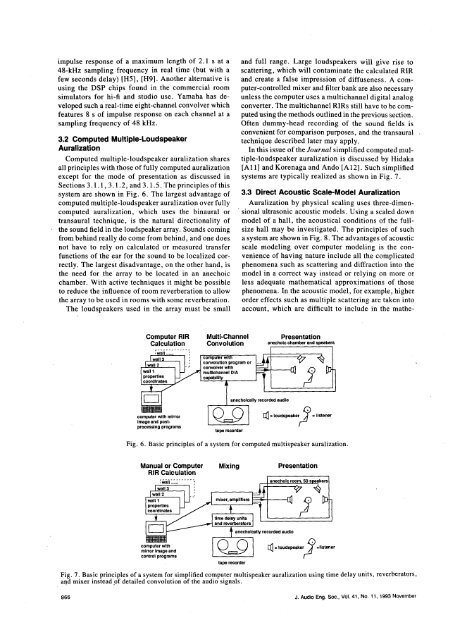Auralization An Overview* - Matt Montag
Auralization An Overview* - Matt Montag
Auralization An Overview* - Matt Montag
Create successful ePaper yourself
Turn your PDF publications into a flip-book with our unique Google optimized e-Paper software.
impulse response of a maximum length of 2.1 s at a and full range. Large loudspeakers will give rise to<br />
48-kHz sampling frequency in real time (but with a scattering, which will contaminate the calculated RIR<br />
few seconds delay) iH5], iH9]. <strong>An</strong>other alternative is and create a false impression of diffuseness. A eomusing<br />
the DSP chips found in the commercial room puter-controlled mixer and filter bank are also necessary<br />
simulators for hi-fi and studio use. Yamaha has de- unless the computer uses a multichannel digital analog<br />
veloped such a real-time eight-channel convolver which converter. The multichannel RIRs still have to be cornfeatures<br />
8 s of impulse response on each channel at a puted using the methods outlined in the previous section.<br />
sampling frequency of 48 kHz. Often dummy-head recording of the sound fields is<br />
convenient for comparison purposes, and the transaural ,<br />
3.2 Computed Multiple-Loudspeaker technique described later may apply.<br />
<strong>Auralization</strong> In this issue of the Journal simplified computed mul-<br />
Computed multiple-loudspeaker auralization shares tiple-loudspeaker auralization is discussed by Hidaka<br />
all principles with those of fully computed auralization iA 11] and Korenaga and <strong>An</strong>do iA 12]. Such simplified<br />
except for the mode of presentation as discussed in systems are typically realized as shown in Fig. 7.<br />
Sections 3.1.1,3.1.2, and 3.1.5. The principles of this<br />
system are shown in Fig. 6. The largest advantage of 3.3 Direct Acoustic Scale-Model <strong>Auralization</strong><br />
computed multiple-loudspeaker auralization over fully <strong>Auralization</strong> by physical scaling uses three-dimencomputed<br />
auralization, which uses the binaural or ' sional ultrasonic acoustic models. Using a scaled down<br />
transaural technique, is the natural directionality of model of a hall, the acoustical conditions of the fullthe<br />
sound field in the loudspeaker array. Sounds coming size hall may be investigated. The principles of such<br />
from behind really do come from behind, and one does a system are shown in Fig. 8. The advantages of acoustic<br />
not have to rely on calculated or measured transfer scale modeling over computer modeling is the confunctions<br />
of the ear for the sound to be localized cor- venience of having nature include all the complicated<br />
rectly. The largest disadvantage, on the other hand, is phenomena such as scattering and diffraction into the<br />
the need for the array to be located in an anechoic model in a correct way instead or relying on more or<br />
chamber. With active techniques it might be possible less adequate mathematical approximations of those<br />
to reduce the influence of room reverberation to allow phenomena. In the acoustic model, for example, higher<br />
the array to be used in rooms with some reverberation, order effects such as multiple scattering are taken into<br />
The loudspeakers used in the array must be small account, which are difficult to include in the mathe-<br />
Computer RIR Multi-Channel Presentation<br />
Calculation Convolution anechoic chamber and speakers<br />
computer with<br />
Iwa,,3 I: Iconvolution program or<br />
wall= Il--: |<br />
Iproperties _J / I capability<br />
convolver with [_ /._<br />
wall1 {a_ multlchannel D/A "_l<br />
Ic°__'"'"_ ' I anecholcally ,, recorded audta<br />
computer with mirror [_ = loudspeaker = listener<br />
image end post- r<br />
processing programs<br />
tape recorder<br />
Fig. 6. Basic principles of a system for computed multispeaker auralization.<br />
Manual or Computer Mixing Presentation<br />
RIR Calculation<br />
J i<br />
:wi{i - [ ........<br />
wa,,3<br />
'<br />
i<br />
I anechoic room, 50 speakers I<br />
h<br />
[wall2 [ | : I --I_--_l '_|<br />
wall1 U' _ mixer, amplifiers .._J_l I [_ _)<br />
} properties [_J /' ' i ' ? I // II<br />
I _ _ 'T anecholcally recorded audio<br />
computer with ['_ =listener<br />
mirror image and<br />
control programs F<br />
tape recorder<br />
Fig. 7. Basic principles of a system for simplified computer multispeaker auralization using time delay units, reverberators,<br />
and mixer instead of detailed convolution of the audio signals.<br />
866 J.AudioEng.Soc,,Vol.41,No.11,1993November


